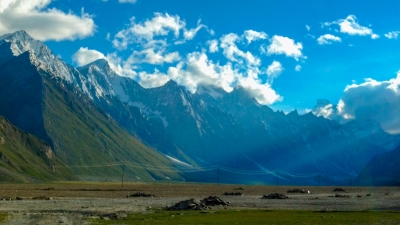By Nivedita KhandekarNew Delhi, June 23 : The barely 10 sq kms Leh town saw a total of 20,918 quintals waste – both biodegradable and non-biodegradable – generated in just 11 months from June 2021 till April 2022.However, of that, only 1,387 quintal waste – plastic bottles, multi-layer plastics, cardboards, tin, etc.
- were sold for reuse while 19,531 quintal waste was deposited at the municipal processing site.
Reason: The increasing tourist inflow in the fragile trans-Himalayan landscape.Due to improving and affordable connectivity, particularly air travel, the tourism sector is booming in India and there has been an immense growth in infrastructure.However, not all growth has been sustainable and the tourists’ have not exactly helped in economic prosperity, rather caused trouble for local landscape and biodiversity.
These are the findings of a damning report ‘Environmental Assessment of Tourism in the Indian Himalayan Region’, submitted to the Environment Ministry in compliance with a National Green Tribunal (NGT) order.The report, submitted earlier this month, was prepared by Govind Ballabh Pant National Institute of Himalayan Environment (NIHE), Almora.
After assessing every single state/UT – UT of Ladakh, UT of Jammu & Kashmir, Himachal Pradesh, Uttarakhand, Sikkim, West Bengal Hills & Darjeeling, Assam Hills, Arunachal Pradesh, Nagaland, Manipur, Mizoram, Tripura and Meghalaya – for tourist numbers, municipal facilities for waste treatment, air and water quality and biodiversity listing etc., the report came up with some common actions/suggestions for the entire Indian Himalayan Region (IHR).
The pointers included estimation of tourist carrying capacity, promotion of green tourism, green-premium tax on tourists, accelerate the de-carbonisation of tourism operations, carbon taxes, bio-fuel subsidies, vehicle purchase subsidies, planning and zoning restrictions, restriction on use of vehicles in eco-sensitive areas, feed-in tariffs for renewable energy, establishment of proper waste segregation and management systems in tourist spots, establishment of eco-friendly bio-digester toilets in high altitude trek routes, etc.
Apart from the worries about water and air quality management – often discussed and written about issues – the report also highlighted that solid waste management has come up as a major problem for the IHR.
For instance, in Uttarakhand, currently there are 91 urban local bodies targeting the population of 34,40,814 generating 1,551.76 MTPD solid waste.There are a total 90 ULBs and 9 Cantonment Boards responsible for implementation of the Municipal Solid Wastes (Management and Handling) Rules, 2000 (SWM, 2016) but most of the ULBs in the Uttarakhand do not comply with the prescribed guidelines, the report said.
Almost all states had more or less the same story.
The state/UT specific suggestion here for solid waste management included water ATMs as an alternative to packaged water; promoting clean water springs for drinking water purposes on the routes; waste recycling units for the segregated wastes instead of transporting it kilometres away to other states; and applying appropriate technologies for direct use, such as use of shredded plastic chips in road constructions.
One of the greatest threats to tourism is the risk of disasters, the report pointed out in the case of Darjeeling, where it has increased with time.
“Earthquakes and landslides are an annual phenomenon here especially during the rainy season which has intensified in the past decades.(But) the lack of technology and irregular monitoring of climate risks results in devastating effects on the tourist destination therefore it is necessary to equip the State with such technology which shall also assure optimal use of resources by preventing damages to infrastructures,” the report said.
In the case of Manipur, the main hurdle of achieving sustainable tourism is the lack of research and knowledge, it said, and suggested, therefore, there is a need not only to study the intricacies of sustainable tourism but also its linkage with climate change.
In several states, the threat to the biodiversity of that state has been reported; however, data on the impact of tourism on the biodiversity is lacking.
Unavailability of separate data sets on tourist influx in protected areas of the state, especially through online portals of the state, is another issue highlighted.
The report also highlighted some of the positive steps taken.
In Arunachal Pradesh, for instance, in 2021, the state adopted ‘Pakke Tiger Reserve 2047 Declaration on Climate Change Resilient and Responsive Arunachal Pradesh’ that aims to promote development that is climate-resilient in the state.The report termed it as a positive move by the state in the direction of sustainable development of all sectors including tourism in the state.
“In some of the over-crowded and mass tourism circuits within Himachal Pradesh and Uttarakhand, some pockets might have gained economic prosperity due to tourism but this could not be true in every state of the IHR particularly the northeastern states.It is, therefore, recommended to conduct more focused studies in terms of economic growth, environmental cost, and tourist carrying capacity to fill up these gaps in the north-eastern states in particular and other remaining states/UTs in general,” the report concluded.
(Nivedita Khandekar can be reached at [email protected])
niv/pgh
#scary #damage #influx #Himalayan #Delhi #Laya # Laya #Arunachal Pradesh # Assam #Delhi #New Delhi #Himachal Pradesh #Jammu #Ladakh #Leh #Manipur #Meghalaya #Mizoram #Nagaland #Sikkim #Tripura #Uttarakhand #West Bengal # Assam #Chase
.






